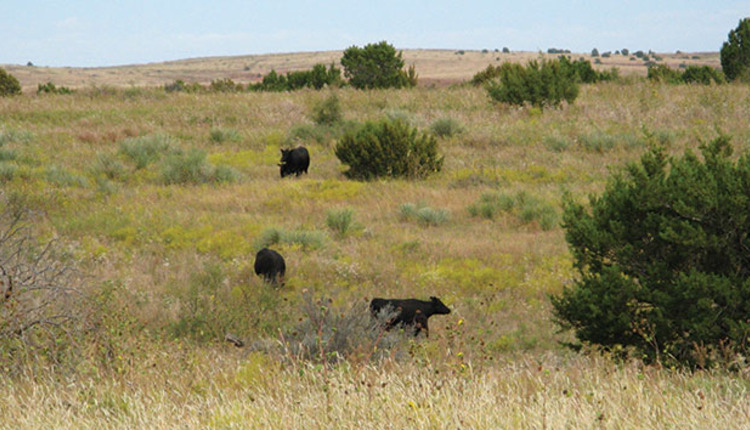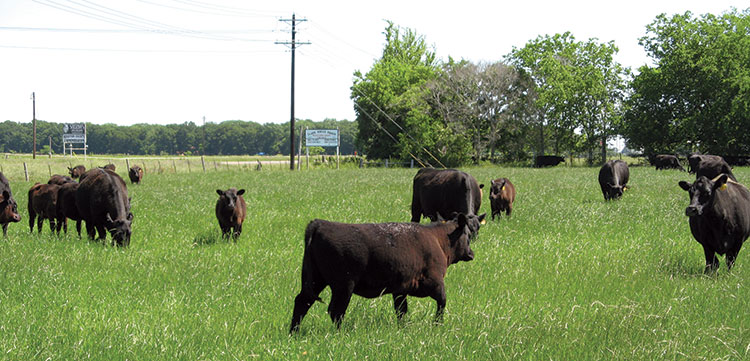
Maintaining proper stocking rates to avoid overgrazing is the number one requirement for a financially successful ranch.
Emi Kimura, an agronomist with Texas A&M AgriLife Extension, discussed overgrazing in a recent webinar presentation sponsored by the Texas Section Society of Range Management. Some of his comments are included here.
Continual monitoring of available forage and adjusting stocking rates to the amount of forage is necessary for maintaining land productivity, healthy ecosystems, and resource preservation for future generations.
Conversely, what are the major benefits from overgrazed pastures?
You might say they provide for easy inspection of the soil texture or for fire protection resulting from lack of forage. Certainly overgrazed pastures allow for less chance of losing golf balls when honing your tee shots or providing a field for baseball games with the family.
If a land manager uses any of these proposed benefits as a reason for overgrazing, serious consideration of a different career is in order.
Simply stated, there are no benefits to overgrazing. In fact, overgrazed pastures struggle during hot, dry summers; cold, wet winters; cold springs when soil nutrient release is slow; and cool falls when soil nutrient release is fast, resulting in high losses.
How should a land manager react to the bladeless appearance of grass in overgrazed pastures? Should the manager avoid making any changes and maintain the current stocking rate?
The results of doing nothing include cost savings on seed and fertilizer, additional daily exercise while feeding hay, and easy monitoring of hoof health. There are many more reasons for doing nothing, but none of them are economically sound.
A pasture requires three years or more to fully recover from overgrazing, so patience is required in order for Mother Nature to heal herself. The first step is to remove all grazing livestock and keep them off until the pasture has fully recovered.
Sometimes it is possible to reduce the recovery time span through pasture renovation, which may include aerating, replanting, fertilizing, and/or controlling weeds. The goal should be to manage animals and pastures in a manner that negates the need for pasture renovation.
Give plants a chance
Proper grazing protocols protect and maintain meristems on forage plants. Meristems are regions of cell division and elongation resulting in plant growth. Apical meristems are found at the top of shoots and are responsible for originating plant growth. Intercalary meristems are located at the base of leaf blades, sheath, and internodes. They promote spring growth flushes of vegetation. Axillary buds are a type of meristem found at the nodes of stems, rhizomes, and stolons. These meristem buds produce new plants.
Plant leaf area and photosynthesis are enhanced through proper grazing management. By definition, photosynthesis is the conversion of sunlight, water, and carbon dioxide (CO2) from the air into carbohydrates and oxygen (O2). It’s these carbohydrates that are converted to sugar and stored in plant roots or stem bases to support plant growth and nutrient uptake.
Size matters
“The sin of all sins is overgrazing,” said Kimura. “Overgrazing results in lower forage production and persistence, as well as causing more water runoff, which allows pollution of streams, rivers, and other bodies of water with fertilizer and sediment. Due to insufficient forage, animal performance is depressed. It also raises the chances of water or wind erosion, weed and brush invasions, and creation of an unusable pasture during drought events,” he added.
Manage native grass and improved grass in different ways because their characteristics are different. Native range contains primarily bunch grasses that are not as tolerant to grazing as sod-forming grasses found in improved pastures. This results from the growing points on native grass being located higher on the stems than on improved grasses where growing points are near the ground. Native grass requires close monitoring for proper grazing management.
Monitoring stubble height provides an indication as to when stocking rates should be adjusted and when a pasture should be grazed. Don’t graze warm-season native grass in the spring until stubble height reaches 15 inches. Beginning too early may prevent plants from developing adequate leaf surface area. More leaves means more photosynthesis, enhancing nutrient and water uptake, which result in additional leaf production. This cycle is necessary for having enough grass to continue grazing through the season.
During spring and early summer, maintain native grass at a height greater than 12 inches so growing points are left intact to stimulate root growth, sugar storage, and uptake of water and nutrients. Maintain stubble height between 15 and 20 inches during mid- and late-summer because forage below that range is lower quality due to plant maturity.
Stop grazing native grass six weeks before the first frost and maintain 15- to 18-inch stubble height during the dormancy period. Plants need enough carbohydrate reserves in their root systems through winter dormancy to maintain the stand and provide plant vigor for spring growth.

Drought response
Properly managed pastures are more drought tolerant than overgrazed pastures because plant root systems are larger and healthier. When drought is in the forecast, lower stocking rates to adjust for less forage production. Pay close attention to plant height during the drought period, keeping adequate forage cover on the landscape.
Soil test earlier than normal and collect more samples. Use the results to formulate a fertilizer application plan based on local recommendations. Dig plants and check the size of the root system to confirm plant health.
Consider overgrazing a sin because it ruins land for future generations. Be a good land steward and strive to leave your pastures and rangelands in better condition than when you began managing them
This article appeared in the April/May 2018 issue of Hay & Forage Grower on pages 26 and 27.
Not a subscriber? Click to get the print magazine

